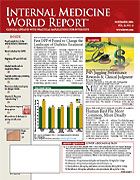Publication
Article
Internal Medicine World Report
Erectile Dysfunction Strong Predictor of Diabetes in Young Men
Author(s):
But Not in Those 65 or Older
>
Diabetes has long been associated with erectile dysfunction (ED), but the distribution in specific age-groups was never clear. Recent evidence suggests that diabetes and ED may share common risk factors, including endothelial dysfunction, autonomic neuropathy, and vascular abnormalities. Now, surprising results of a new study show that ED is a stronger marker of diabetes in younger men aged 18 to 45 years than in elderly men (J Urol. 2006; 176:1081-1085).
This retrospective study included 285,436 men with ED and 1,584,230 men without ED from a national managed care claims database of 28 million Americans. Of men with ED, 21.96% resided in the East, 33.95% in the Midwest, 32.78% in the South, and 11.13% in the West.
The mean age of men with ED was 8.1 to 12.3 years older than that of men without ED.
Prevalence rates of ED ranged from 2.6% in those aged 18 to 25 years to 28.7% in those aged 66 to 75 years.
The overall prevalence of diabetes was 20% in men with ED and 7.5% in men without ED.
The crude age-specific diabetes prevalence rate for those with ED ranged from 1.7% in those aged 18 to 25 years to 24.9% in those aged 66 to 75 years.
The effect of age on diabetes prevalence was nonlinear in the ED and the non-ED cohorts. The odds ratio for diabetes associated with ED ranged from 1.05 (P = .171) in men aged 76 to 85 years to 2.94 (P?<.0001) in men aged 26 to 35 years.
These results suggest that ED can best be used as an early marker of diabetes in younger men (aged 18-45 years). It is also an adequate marker in older men (aged 46-65 years), but is less useful in elderly men aged ≥66 years.
The ratio of diabetes prevalence of men with ED to men without ED was greater in the West and Midwest than in the East and South, and in those aged ?26 to 35 years, 36 to 45 years, and 46 to 55 years than in those aged 18 to 25 years, 56 to 65 years, 66 to 75 years, 76 to 85 years, and 86 years and older.
After adjusting for age, geographic region, and concurrent disease, the odds for having diabetes were 60% higher in men with ED than in those without ED.
Of concurrent factors with a significant influence on the likelihood of having diabetes (P?<.001), older age had the most significant effect, followed by hypertension, obesity, hyperlipidemia, ischemic heart disease, and cerebrovascular disease.
"Considering the nonlinear distribution of odds ratios of having diabetes between men with ED and men without ED across age-groups, we support the use of ED as an observable early marker of diabetes strongly for men 45 years old or younger, as a likely marker for men 46 to 65 years old, but not for men 66 years old or older," concluded Allen Seftel, MD, and colleagues, of Case Western University School of Medicine.






